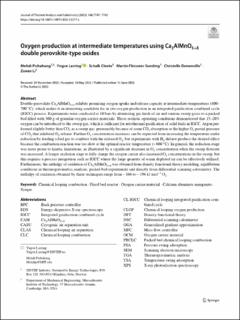| dc.contributor.author | Pishahang, Mehdi | |
| dc.contributor.author | Larring, Yngve | |
| dc.contributor.author | Cloete, Schalk Willem Petrus | |
| dc.contributor.author | Sunding, Martin Fleissner | |
| dc.contributor.author | Denonville, Christelle | |
| dc.contributor.author | Li, Zuoan | |
| dc.date.accessioned | 2024-04-10T12:52:14Z | |
| dc.date.available | 2024-04-10T12:52:14Z | |
| dc.date.created | 2023-06-29T16:03:40Z | |
| dc.date.issued | 2023 | |
| dc.identifier.citation | Journal of Thermal Analysis and Calorimetry. 2023, 148 (15), 7747-7765. | en_US |
| dc.identifier.issn | 1388-6150 | |
| dc.identifier.uri | https://hdl.handle.net/11250/3125837 | |
| dc.description.abstract | Double-perovskite Ca2AlMnO5+δ exhibits promising oxygen uptake and release capacity at intermediate temperatures (400–700 °C), which makes it an interesting candidate for in situ oxygen production in an integrated gasification combined cycle (IGCC) process. Experiments were conducted at 10 bars by alternating gas feeds of air and various sweep gases to a packed bed filled with 300 g of granular oxygen carrier materials. These realistic operating conditions demonstrated that 15–20% oxygen can be introduced to the sweep gas, which is sufficient for autothermal gasification of solid fuels in IGCC. Argon performed slightly better than CO2 as a sweep gas, presumably because of some CO2 absorption or the higher O2 partial pressure of CO2 that inhibited O2 release. Further O2 concentration increases can be expected from increasing the temperature under reduction by feeding a fuel gas to combust with the released O2, but experiments with H2 did not produce the desired effect because the combustion reaction was too slow at the optimal reactor temperature (~ 600 °C). In general, the reduction stage was more prone to kinetic limitations, as illustrated by a significant decrease in O2 concentration when the sweep flowrate was increased. A longer oxidation stage to fully charge the oxygen carrier also increased O2 concentrations in the sweep, but this requires a process integration such as IGCC where the large quantity of warm depleted air can be effectively utilized. Furthermore, the enthalpy of oxidation of Ca2AlMnO5+δ was obtained from density functional theory modeling, equilibrium conditions in thermogravimetric analysis, packed bed experiments and directly from differential scanning calorimetry. The enthalpy of oxidation obtained by these techniques range from − 166 to − 196 kJ mol−1 O2. | en_US |
| dc.language.iso | eng | en_US |
| dc.publisher | Springer Nature | en_US |
| dc.rights | Navngivelse 4.0 Internasjonal | * |
| dc.rights.uri | http://creativecommons.org/licenses/by/4.0/deed.no | * |
| dc.title | Oxygen production at intermediate temperatures using Ca2AlMnO5+δ double perovskite-type oxides | en_US |
| dc.title.alternative | Oxygen production at intermediate temperatures using Ca2AlMnO5+δ double perovskite-type oxides | en_US |
| dc.type | Peer reviewed | en_US |
| dc.type | Journal article | en_US |
| dc.description.version | publishedVersion | en_US |
| dc.rights.holder | © The Author(s) 2023. Published by Springer Nature under a CC-BY license. | en_US |
| dc.source.pagenumber | 7747-7765 | en_US |
| dc.source.volume | 148 | en_US |
| dc.source.journal | Journal of Thermal Analysis and Calorimetry | en_US |
| dc.source.issue | 15 | en_US |
| dc.identifier.doi | 10.1007/s10973-023-12277-z | |
| dc.identifier.cristin | 2159590 | |
| dc.relation.project | Norges forskningsråd: 239802 | en_US |
| cristin.ispublished | true | |
| cristin.fulltext | original | |
| cristin.qualitycode | 1 | |

